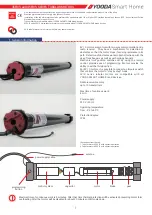
Section 5 - Maintenance
90-8M0057081
eng
MARCH 2011
Page 83
NOTICE
Operating the engine out of the water at high speeds creates suction, which can collapse the water supply hose and overheat
the engine. Do not operate the engine above 1400 RPM out of the water and without sufficient cooling water supply.
8. Operate the engine with the sterndrive in neutral at a fast idle between 600 to 1400 RPM for about 10 minutes or until discharge
water is clear.
9. Monitor the water temperature gauge to ensure that the engine is operating normally.
10. Slowly return the throttle to the idle speed position.
11. Stop the engine.
12. Shut off the water supplies.
13. Remove the sterndrive flushing attachments.
14. Remove any adaptors used and reconnect the seawater hoses.
Engine Seawater Pump Inspection
IMPORTANT: Cummins MerCruiser Diesel strongly recommends that this service be performed by a Cummins MerCruiser Diesel
Authorized Repair Facility.
Remove and inspect the engine seawater pump at the interval specified in the
Maintenance Schedule
. See your Cummins
MerCruiser Diesel Authorized Repair Facility.
Alpha Sterndrive Seawater Pump Inspection
IMPORTANT: Cummins MerCruiser Diesel strongly recommends that this service be performed by a Cummins MerCruiser Diesel
Authorized Repair Facility.
Remove and inspect the Alpha sterndrive seawater pump at the interval specified in the
Maintenance Schedule
. See your
Cummins MerCruiser Diesel Authorized Repair Facility.
Replacing the Engine Coolant
Draining the Closed Cooling System
IMPORTANT: Due to the complex nature of this service Cummins MerCruiser Diesel strongly recommends that this service be
performed by a Cummins MerCruiser Diesel Authorized Repair Facility.
NOTICE
Discharge of oil, coolant, or other engine/drive fluids into the environment is restricted by law. Use caution not to spill oil, coolant,
or other fluids into the environment when using or servicing your boat. Be aware of the local restrictions governing the disposal
or recycling of waste, and contain and dispose of fluids as required.
NOTE: For instructions on draining the seawater section, see
Draining the Seawater System
in this section.
IMPORTANT: Observe the following points.
•
Ensure that the engine is as level as possible to promote complete draining of the cooling system.
•
The closed cooling section must be filled year‑round with the required coolant. If the engine will be exposed to freezing
temperatures, ensure that the closed cooling section is filled with a solution of low silicate ethylene glycol antifreeze and
deionized, purified water properly mixed to protect the engine to the lowest temperature to which it will be exposed.
•
Do not use propylene glycol antifreeze in the closed cooling section of the engine.
!
CAUTION
A sudden loss of pressure can cause hot coolant to boil and discharge violently resulting in serious injury from burns. Allow the
engine to cool down before removing the coolant pressure cap.
1. Allow the engine to cool.
2. Remove the pressure cap from the expansion tank and coolant reservoir.
3. Remove the fuel filter for access to the engine coolant drain plug. See
Water–Separating Fuel Filter
.
















































